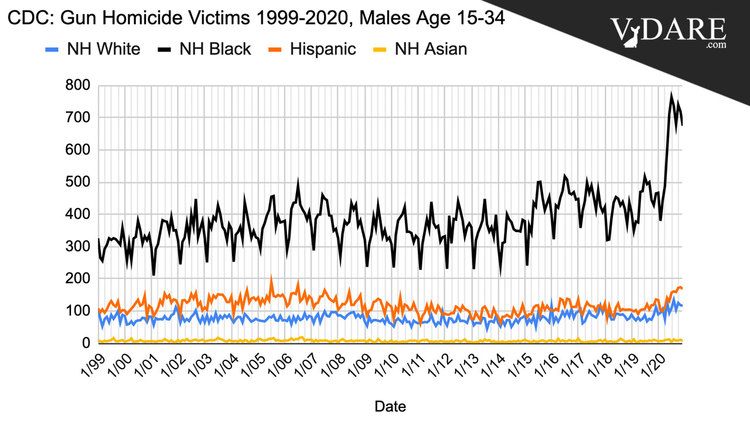![]()
On May 10, 2022, the CDC issued a new report on gun homicides and gun suicides in 2020. Not in 2021, which ended over 4 months ago, but in 2020, which ended over 16 months ago.
Still, 2020 was an important year, so I pulled up the CDC’s Wonder database and graphed the number of male 15-34 year old victims of gun homicides by race by month from 1999 to 2020. Why youngish males?
Unlike the FBI, which tries to count both victims and perpetrators of murders, the CDC records only victims of homicides. (But the CDC handles Hispanics much more adeptly than the FBI does.)
So one problem with the CDC’s demographics is it doesn’t tell you the demographics of the perps. But by focusing on victims in the lively sector — young men — you can get a pretty good sense of who is doing the shooting as well.
And it sure looks to me like America has a young black male shooting problem, both in general and especially during the current Racial Reckoning following George Floyd’s death. It would seem like the Establishment consensus that the biggest problem facing young black men was too much law and order has definitively been tested in the real world since 5/25/20.
But you won’t hear that from the CDC, at least not in those words.
Highlights from the CDC report:
Results: From 2019 to 2020, the overall firearm homicide rate increased 34.6%, from 4.6 to 6.1 per 100,000 persons.
The overall age-adjusted firearm suicide rate among persons aged ≥10 years remained nearly level between 2019 and 2020 (7.9 and 8.1 per 100,000 persons, respectively [relative change = 1.5%]) …
However, drug overdose deaths were up dramatically in 2020, likely due to drug dealers adding fentanyl to other recreational drugs to enhance the effects. (E.g., George Floyd might well have not known his meth had fentanyl in it. But nobody is supposed to ever be reminded of Floyd’s fentanyl ingestion, even though it might save a lot of lives.)
Young persons, males, and Black persons consistently have the highest firearm homicide rates, and these groups experienced the largest increases in 2020. These increases represent the widening of long-standing disparities in firearm homicide rates. For example, the firearm homicide rate among Black males aged 10–24 years was 20.6 times as high as the rate among White males of the same age in 2019, and this ratio increased to 21.6 in 2020. …
Gun homicide victimizations increased 39.5% among blacks from 2019 to 2020, 28.4% among non-Hispanic whites, 27.0% among American Indians, 25.8% among Hispanics, but fell 4.2% among Asians despite Trump uttering the genocidal words “China virus.”
The findings of this study underscore the importance of comprehensive strategies that can stop violence now and in the future by addressing factors that contribute to homicide and suicide, including the underlying economic, physical, and social inequities that drive racial and ethnic disparities in multiple health outcomes. For example, policies that enhance economic and household stability (e.g., temporary assistance to families, child care subsidies, tax credits, housing assistance, and livable wages) can reduce family poverty and other risk factors for homicide and suicide (e.g., family stress and substance use) (3,4,12–14). Communities can also implement locally driven approaches that address physical and social environments that contribute to violence and other inequities, with the potential for immediate benefits. Approaches such as enhancing and maintaining green spaces and the remediation of vacant buildings can reduce opportunities for violence and promote positive social interactions. These approaches have been associated with significant reductions in risk for firearm violence (13,15). For example, a study in a major U.S. city found that restoration of vacant lots (e.g., cleaning up debris or adding vegetation) was associated with significant reductions in firearm assaults, with the largest reduction (29%) in areas with the highest poverty (15).
Or, you know, we could go back to policing like on May 24, 2020 and try to get illegal handguns out of the pockets and glove compartments of criminals. That might have a more immediate effect than, say, enhancing and maintaining green spaces. Not that those aren’t good things to do, but when you find your hole is 34.6% deeper than last year, the first thing to do is to stop digging.
Here’s my graph focusing on 2014-2020.
![]()
You can see the Ferguson Effect take hold in 2015-2016, then the Pax Sessions of 2018 after the Justice Department stopped egging on criminals like the Obama Justice Department had during the Black Lives Matter era after Ferguson. But then black males started getting restless in 2019, and more so in the winter of 2020, then the doors blew off in June 2020 with murders peaking in July 2020 and remaining extraordinarily high for the rest of the year.
In contrast, the CDC and the press doesn’t want to report the CDC’s own numbers by month so they can blame the pandemic rather than focus attention on the racial reckoning.
[Comment at Unz.com]















